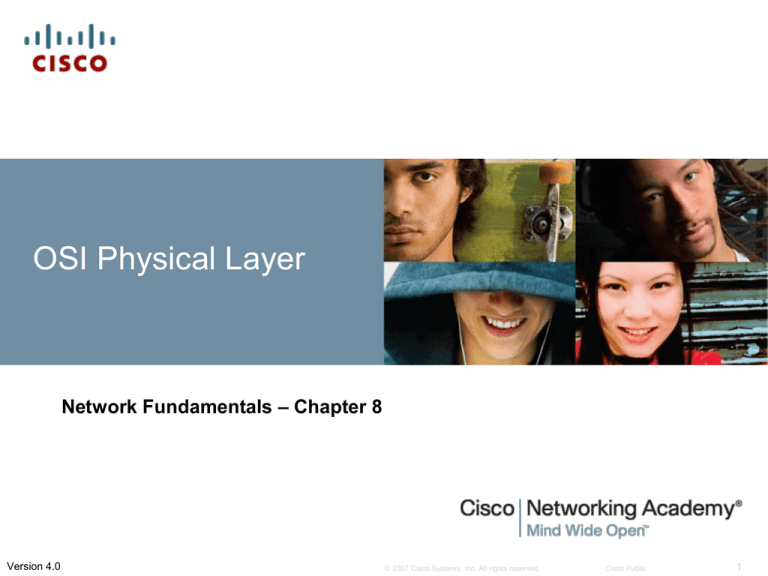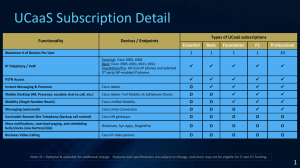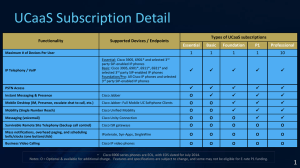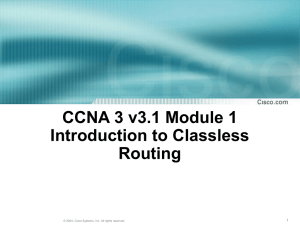
OSI Physical Layer
Network Fundamentals – Chapter 8
Version 4.0
© 2007 Cisco Systems, Inc. All rights reserved.
Cisco Public
1
Objectives
Explain the role of Physical layer protocols and
services in supporting communication across data
networks.
Describe the role of signals used to represent bits as
a frame as the frame is transported across the local
media.
Describe the purpose of Physical layer signaling and
encoding as they are used in networks.
Identify the basic characteristics of copper, fiber and
wireless network media.
Describe common uses of copper, fiber and wireless
network media.
© 2007 Cisco Systems, Inc. All rights reserved.
Cisco Public
2
Physical Layer Protocols & Services
The role of the OSI physical layer is to
encode the binary digits that represent data link layer frames
into signals and
to transmit and receive these signals cross the physical media
—copper wires, optical fiber, and wireless that connect network
devices.
The physical medium is capable of conducting a signal
in the form of voltage, light, or radio waves from one
device to another.
© 2007 Cisco Systems, Inc. All rights reserved.
Cisco Public
3
Purpose of the Physical layer
© 2007 Cisco Systems, Inc. All rights reserved.
Cisco Public
4
Physical Layer Protocols & Services
The delivery of frames across the local media requires
the following physical layer elements:
■ The physical media and associated connectors
■ A representation of bits on the media
■ Encoding of data and control information
■ Transmitter and receiver circuitry on the network devices
© 2007 Cisco Systems, Inc. All rights reserved.
Cisco Public
5
Physical Layer Protocols & Services
© 2007 Cisco Systems, Inc. All rights reserved.
Cisco Public
6
Physical Layer Operation
Each medium has unique signaling used to represent
the bits in the data-link frames.
IP is media independent, so the frames remain
unchanged as they cross to the next device.
© 2007 Cisco Systems, Inc. All rights reserved.
Cisco Public
7
Physical Layer Operation
When the physical layer puts a frame out onto media, it
generates a set patterns of bits, or signal pattern, that
can be understood by the receiving device.
Many OSI Layer 1 technologies require the adding of
signals at the beginning and the end of frames.
To mark the beginning and end of frames, the
transmitting device uses a bit pattern that is unique and
is only used to identify the start or end of frames.
© 2007 Cisco Systems, Inc. All rights reserved.
Cisco Public
8
Physical Layer Operation
© 2007 Cisco Systems, Inc. All rights reserved.
Cisco Public
9
Physical Layer Standards
Physical layer performs functions very different from the
other OSI layers.
The upper layers perform logical functions carried out
by instructions in software.
The upper OSI layers were designed by software
engineers and computer scientists who designed the
services and protocols in the TCP/IP suite as part of the
Internet Engineering Task Force (IETF).
© 2007 Cisco Systems, Inc. All rights reserved.
Cisco Public
10
Physical Layer Standards
By contrast, the physical layer, + data link layer, defines
hardware specifications, including electronic circuitry,
media, and connectors.
Physical layer specifications were defined by electrical
and communications engineering organizations.
Some of the key organizations:
■ The International Organization for Standardization (ISO)
■ The Institute of Electrical and Electronics Engineers (IEEE)
■ The American National Standards Institute (ANSI)
■ The International Telecommunication Union (ITU)
■ The Electronics Industry Alliance/Telecommunications
Industry Association (EIA/TIA)
■ National telecommunications authorities such as the Federal
Communications Commission (FCC) in the United States
© 2007 Cisco Systems, Inc. All rights reserved.
Cisco Public
11
Physical Layer Fundamental Principles
© 2007 Cisco Systems, Inc. All rights reserved.
Cisco Public
12
Physical Layer Fundamental Principles
Three components of Layer 1 communication are key
to understanding how the physical layer functions:
■ Physical components
■ Encoding
■ Signaling
There is some parallel between human communication
and the processes of the physical layer
© 2007 Cisco Systems, Inc. All rights reserved.
Cisco Public
13
Physical Layer Fundamental Principles
A person wants to communicate an idea -> processes
an abstract thought into words (signaling)-> encoded
into speech sounds (encoding) -> sent out through the
medium of air (physical).
At the other end, the receiver interprets the signal of
sound, recognizes patterns in the sound that denote
words, and then processes the meaning of the words
into the original idea
© 2007 Cisco Systems, Inc. All rights reserved.
Cisco Public
14
Physical Layer Fundamental Principles
Exploring the analogy further, humans can be media
independent when communicating by using a medium
other than sound signals through the air.
Gestures are conveyed in light, and
written letters are conveyed by ink and paper.
Each of these media has a unique way of ordering bits
of communication into recognizable patterns indicating
when messages begin and end.
© 2007 Cisco Systems, Inc. All rights reserved.
Cisco Public
15
Physical Layer Fundamental Principles
© 2007 Cisco Systems, Inc. All rights reserved.
Cisco Public
16
Physical Layer Fundamental Principles
Encoding is another major function of the physical
layer.
One of the functions of encoding is control information.
Just as human speech uses pauses to indicate the
start and end of sentences,
the physical layer inserts a control code to indicate the
beginning and end of frames.
The control code is a specific pattern of 1s and 0s
added to each end of the encoded frame.
© 2007 Cisco Systems, Inc. All rights reserved.
Cisco Public
17
Physical Layer Signaling and Encoding
There are several different methods of
representing binary digits on physical media as
a signal.
Each method finds a way to convert a pulse of
energy into a defined amount of time known as
a bit time.
Bit time is the time it takes for a NIC at OSI
Layer 2 to generate 1 bit of data and send it out
to the media as a signal.
Ex: network interface card (NIC) at a
determined speed, such as 10 Mbits/s.
© 2007 Cisco Systems, Inc. All rights reserved.
Cisco Public
18
Physical Layer Signaling and Encoding
Different signaling methods vary in the way they
represent bits in the bit time.
Three possible variations of a signal that can
represent encoded bits are
■ Amplitude
■ Frequency
■ Phase
© 2007 Cisco Systems, Inc. All rights reserved.
Cisco Public
19
Physical Layer Signaling and Encoding
Explain that network communication at this layer
consists of individual bits encoded onto the Physical
layer and describe the basic encoding techniques
© 2007 Cisco Systems, Inc. All rights reserved.
Cisco Public
20
Physical Layer Signaling and Encoding
Signaling methods can be very complex.
Two methods
•nonreturn to zero (NRZ) and
•Manchester encoding
provides a fundamental for understanding of their
function in the physical layer.
© 2007 Cisco Systems, Inc. All rights reserved.
Cisco Public
21
Nonreturn to Zero
The signaling method known as nonreturn to zero
(NRZ) samples the voltage level on the medium during
a bit time.
A low voltage being 0 and a higher voltage representing
a 1.
© 2007 Cisco Systems, Inc. All rights reserved.
Cisco Public
22
Manchester Encoding
Manchester encoding is a signaling method that looks
for a change in voltage in the middle of a bit time.
A voltage change from low to high within the bit time
represents a 1.
Conversely, a voltage drop within the bit time from a
high to a low voltage represents a 0.
© 2007 Cisco Systems, Inc. All rights reserved.
Cisco Public
23
Physical Layer Signaling and Encoding
© 2007 Cisco Systems, Inc. All rights reserved.
Cisco Public
24
Data-Carrying Capacity
Each physical layer medium carries data at a different
speed.
There are three different ways to analyze the transfer
speed of data on a medium:
■ Theoretically as bandwidth
■ Practically as throughput
■ Qualitatively as goodput
© 2007 Cisco Systems, Inc. All rights reserved.
Cisco Public
25
Data-Carrying Capacity
Bandwidth - Theoretically
•Bandwidth is the capacity of a medium to carry data in a given
amount of time.
•The standard measure for bandwidth is in bits per second
(bps).
•As the technologies have improved over the years, it has
become more practical to refer to bandwidth in kilobits, or
thousands of bits per second (kbps), and megabits, or millions
of bits per second (Mbps).
© 2007 Cisco Systems, Inc. All rights reserved.
Cisco Public
26
Data-Carrying Capacity
Throughput - Practically
•Throughput is the actual transfer rate of data over the medium
in a period of time.
•Throughput, like bandwidth, is measured in bits per second.
•Many factors influence throughput, including the following:
• The amount of traffic
• The type of traffic
• The number of network devices encountered on the
network being measured
© 2007 Cisco Systems, Inc. All rights reserved.
Cisco Public
27
Data-Carrying Capacity
Goodput - Qualitatively
•Goodput is the transfer rate of actual usable data bits.
•The difference between goodput and throughput can vary
greatly depending on the quality of network connections and
devices.
•Goodput is throughput minus traffic overhead for establishing
sessions, acknowledgments, and encapsulation.
•As an example,
•The bandwidth of the LAN is 100 Mbps.
•Because of the sharing and media overhead, the throughput is
only 60 Mbps.
•With the overhead of the encapsulation process of the TCP/IP
stack, goodput, is only 40 Mbps.
© 2007 Cisco Systems, Inc. All rights reserved.
Cisco Public
28
Data-Carrying Capacity
© 2007 Cisco Systems, Inc. All rights reserved.
Cisco Public
29
Physical Media: Connecting Communication
The physical layer defines how bits are presented in the
form of voltage, light pulses, and radio signals.
Several different Ethernet standards for copper and
fiber-optic media:
© 2007 Cisco Systems, Inc. All rights reserved.
Cisco Public
30
Copper Media
The most pervasive media in use for data transfer in
local networks is copper.
There are different types of copper cable designed to
meet the specific needs of different networks.
The most common is unshielded twisted-pair (UTP)
cabling, as it is used in Ethernet LANs.
Others are coaxial cable and shielded twisted-pair
cables.
Copper is an effective medium because it conducts
electrical signals very well, but it has its limitations.
© 2007 Cisco Systems, Inc. All rights reserved.
Cisco Public
31
Copper Media : Limitations
Data travels on copper cables as small pulses of
electrical voltage.
The voltage is quite low and easily distorted by outside
interference and signal attenuation.
Attenuation is the loss of energy in a signal as it travels
longer distances.
Signals are susceptible to interference or noise from
outside the communications system.
Radio waves and electromagnetic devices, such as
fluorescent lights, electric motors, and other devices,
are potential sources of noise.
© 2007 Cisco Systems, Inc. All rights reserved.
Cisco Public
32
Characteristics & Uses of Network Media
© 2007 Cisco Systems, Inc. All rights reserved.
Cisco Public
33
UTP
The most common copper network media is unshielded
twisted-pair (UTP) cable.
UTP in Ethernet consists of eight wires twisted into four
color-coded pairs and then wound inside a cable jacket.
© 2007 Cisco Systems, Inc. All rights reserved.
Cisco Public
34
UTP
The colored pairs identify the wires for proper
connection at the terminals.
There are several categories of UTP cable. Each
category indicates a level of bandwidth performance as
defined by the IEEE.
Category 3 (Cat 3) to Category 5 (Cat 5), 100-megabit
transmissions.
In 1999, Cat 5e, full-duplex Fast Ethernet gigabit
In 2002, Category 6 (Cat 6). Allow higher performance
and less crosstalk.
© 2007 Cisco Systems, Inc. All rights reserved.
Cisco Public
35
UTP : Connector
The most common UTP cable connector in LAN
devices is an RJ-45 connector.
Most computers accessing a network through cable use
an RJ-45 connector plugged into the computer network
interface card at one end and a hub or switch device at
the other.
© 2007 Cisco Systems, Inc. All rights reserved.
Cisco Public
36
Coaxial cable
One of the first types of copper cable used
Has a single, coated copper wire center and an outer
metal mesh that acts as both a grounding circuit and an
electromagnetic shield to reduce interference.
© 2007 Cisco Systems, Inc. All rights reserved.
Cisco Public
37
Shielded Twisted Pair
Technology that has become less commonly used in
recent years.
STP cable combines two methods of noise reduction by
twisting the pairs of wire inside the cable to reduce
interference and then shielding the cable in a wire
mesh.
© 2007 Cisco Systems, Inc. All rights reserved.
Cisco Public
38
Copper Media Safety
Because copper carries electrical current, there is an
inherent risk in using it.
© 2007 Cisco Systems, Inc. All rights reserved.
Cisco Public
39
TBC….
© 2007 Cisco Systems, Inc. All rights reserved.
Cisco Public
40









